Page 304 of 474
303 Operation
Engine compartment
Batteries contain materials that can harm
the environment if disposed of improperly.
Recycling of batteries is the preferred
method of disposal. Many states require
sellers of batteries to accept old batteries
for recycling.
Warning!G
Observe all safety instructions and precau-
tions when handling automotive batteries.
Risk of explosion.
Fire, open flames and smoking
are prohibited when handling
batteries. Avoid creating sparks.
Battery acid is caustic. Do not
allow it to come into contact
with skin, eyes or clothing.
Wear suitable protective cloth-
ing, especially gloves, apron and
faceguard.
Wear eye protection.
Rinse any acid spills immediate-
ly with clear water. Contact a
physician if necessary.
Keep children away.
Follow the instructions in this
Operator’s Manual.
Page 336 of 474
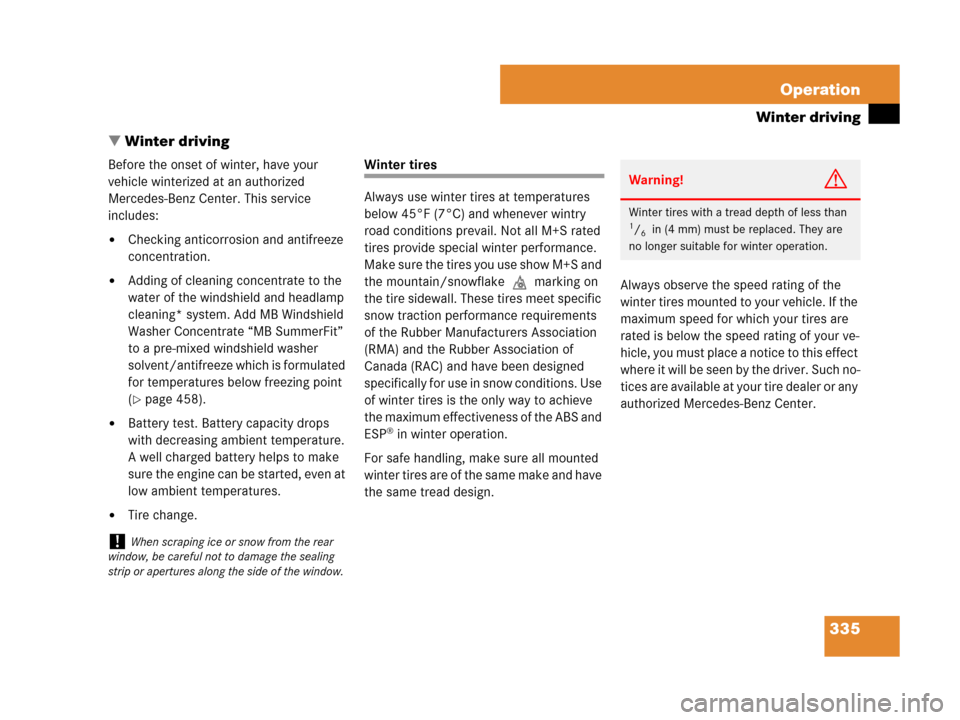
335 Operation
Winter driving
�Winter driving
Before the onset of winter, have your
vehicle winterized at an authorized
Mercedes-Benz Center. This service
includes:
�Checking anticorrosion and antifreeze
concentration.
�Adding of cleaning concentrate to the
water of the windshield and headlamp
cleaning* system. Add MB Windshield
Washer Concentrate “MB SummerFit”
to a pre-mixed windshield washer
solvent/antifreeze which is formulated
for temperatures below freezing point
(
�page 458).
�Battery test. Battery capacity drops
with decreasing ambient temperature.
A well charged battery helps to make
sure the engine can be started, even at
low ambient temperatures.
�Tire change.
Winter tires
Always use winter tires at temperatures
below 45°F (7°C) and whenever wintry
road conditions prevail. Not all M+S rated
tires provide special winter performance.
Make sure the tires you use show M+S and
the mountain/snowflake.marking on
the tire sidewall. These tires meet specific
snow traction performance requirements
of the Rubber Manufacturers Association
(RMA) and the Rubber Association of
Canada (RAC) and have been designed
specifically for use in snow conditions. Use
of winter tires is the only way to achieve
the maximum effectiveness of the ABS and
ESP
® in winter operation.
For safe handling, make sure all mounted
winter tires are of the same make and have
the same tread design.Always observe the speed rating of the
winter tires mounted to your vehicle. If the
maximum speed for which your tires are
rated is below the speed rating of your ve-
hicle, you must place a notice to this effect
where it will be seen by the driver. Such no-
tices are available at your tire dealer or any
authorized Mercedes-Benz Center.
!When scraping ice or snow from the rear
window, be careful not to damage the sealing
strip or apertures along the side of the window.
Warning!G
Winter tires with a tread depth of less than 1/6 in (4 mm) must be replaced. They are
no longer suitable for winter operation.
Page 340 of 474
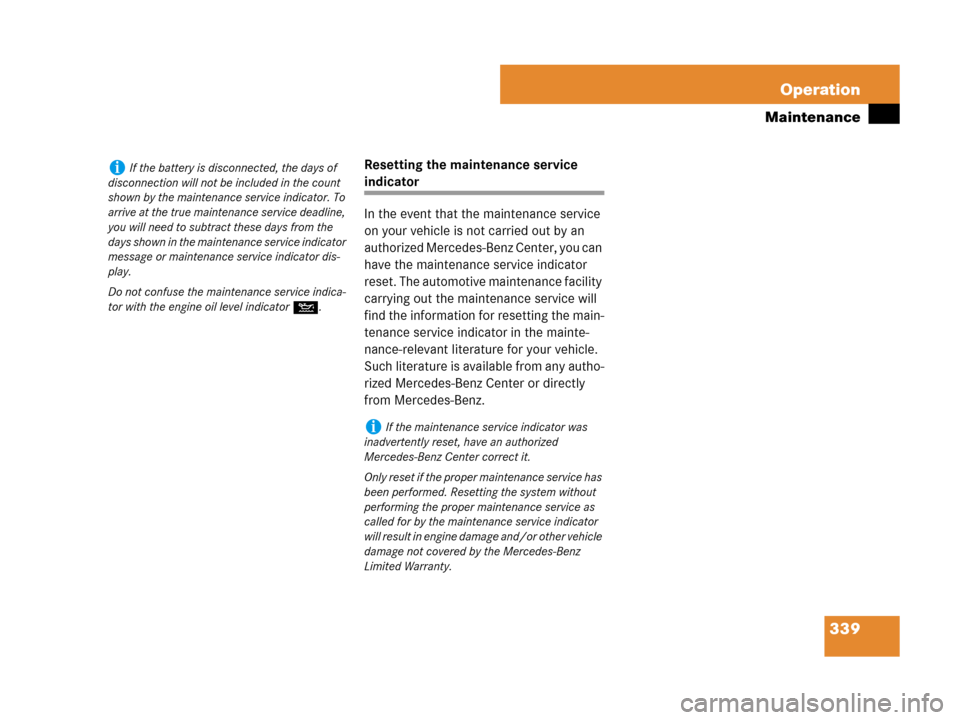
339 Operation
Maintenance
Resetting the maintenance service
indicator
In the event that the maintenance service
on your vehicle is not carried out by an
authorized Mercedes-Benz Center, you can
have the maintenance service indicator
reset. The automotive maintenance facility
carrying out the maintenance service will
find the information for resetting the main-
tenance service indicator in the mainte-
nance-relevant literature for your vehicle.
Such literature is available from any autho-
rized Mercedes-Benz Center or directly
from Mercedes-Benz.iIf the battery is disconnected, the days of
disconnection will not be included in the count
shown by the maintenance service indicator. To
arrive at the true maintenance service deadline,
you will need to subtract these days from the
days shown in the maintenance service indicator
message or maintenance service indicator dis-
play.
Do not confuse the maintenance service indica-
tor with the engine oil level indicatorN.
iIf the maintenance service indicator was
inadvertently reset, have an authorized
Mercedes-Benz Center correct it.
Only reset if the proper maintenance service has
been performed. Resetting the system without
performing the proper maintenance service as
called for by the maintenance service indicator
will result in engine damage and/or other vehicle
damage not covered by the Mercedes-Benz
Limited Warranty.
Page 343 of 474
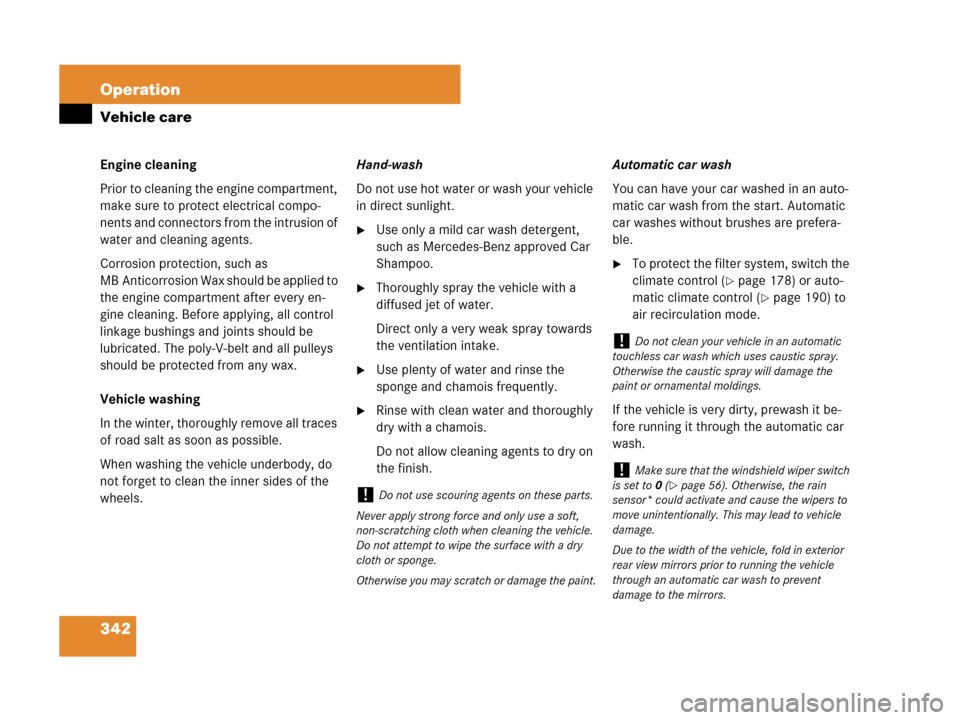
342 Operation
Vehicle care
Engine cleaning
Prior to cleaning the engine compartment,
make sure to protect electrical compo-
nents and connectors from the intrusion of
water and cleaning agents.
Corrosion protection, such as
MB Anticorrosion Wax should be applied to
the engine compartment after every en-
gine cleaning. Before applying, all control
linkage bushings and joints should be
lubricated. The poly-V-belt and all pulleys
should be protected from any wax.
Vehicle washing
In the winter, thoroughly remove all traces
of road salt as soon as possible.
When washing the vehicle underbody, do
not forget to clean the inner sides of the
wheels.Hand-wash
Do not use hot water or wash your vehicle
in direct sunlight.
�Use only a mild car wash detergent,
such as Mercedes-Benz approved Car
Shampoo.
�Thoroughly spray the vehicle with a
diffused jet of water.
Direct only a very weak spray towards
the ventilation intake.
�Use plenty of water and rinse the
sponge and chamois frequently.
�Rinse with clean water and thoroughly
dry with a chamois.
Do not allow cleaning agents to dry on
the finish.Automatic car wash
You can have your car washed in an auto-
matic car wash from the start. Automatic
car washes without brushes are prefera-
ble.
�To protect the filter system, switch the
climate control (
�page 178) or auto-
matic climate control (
�page 190) to
air recirculation mode.
If the vehicle is very dirty, prewash it be-
fore running it through the automatic car
wash.
!Do not use scouring agents on these parts.
Never apply strong force and only use a soft,
non-scratching cloth when cleaning the vehicle.
Do not attempt to wipe the surface with a dry
cloth or sponge.
Otherwise you may scratch or damage the paint.
!Do not clean your vehicle in an automatic
touchless car wash which uses caustic spray.
Otherwise the caustic spray will damage the
paint or ornamental moldings.
!Make sure that the windshield wiper switch
is set to0 (
�page 56). Otherwise, the rain
sensor* could activate and cause the wipers to
move unintentionally. This may lead to vehicle
damage.
Due to the width of the vehicle, fold in exterior
rear view mirrors prior to running the vehicle
through an automatic car wash to prevent
damage to the mirrors.
Page 349 of 474
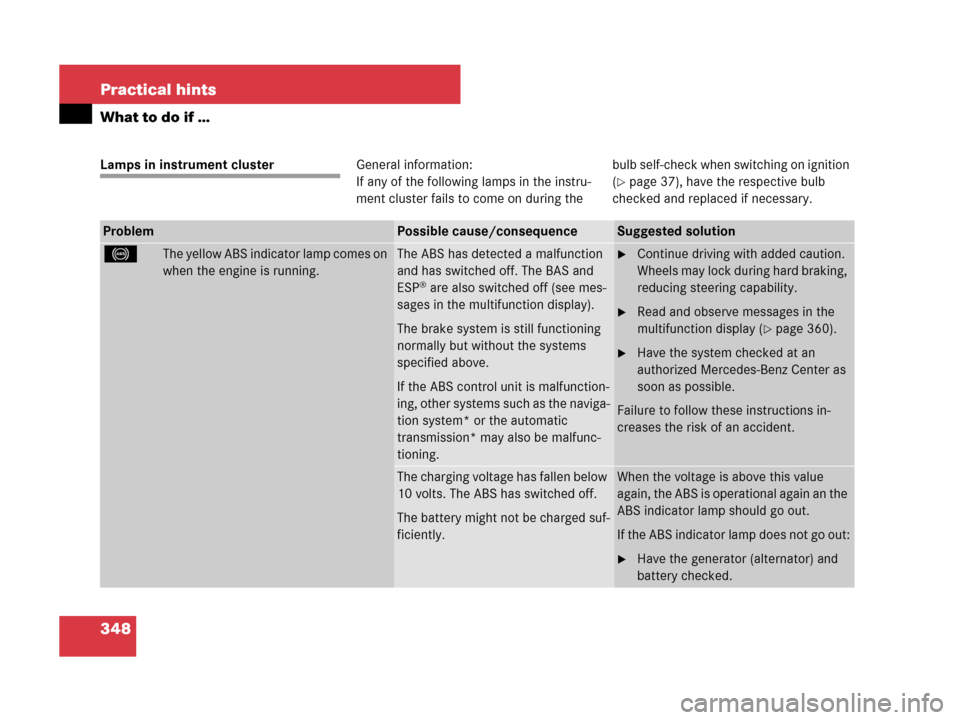
348 Practical hints
What to do if …
Lamps in instrument clusterGeneral information:
If any of the following lamps in the instru-
ment cluster fails to come on during thebulb self-check when switching on ignition
(
�page 37), have the respective bulb
checked and replaced if necessary.
ProblemPossible cause/consequenceSuggested solution
-The yellow ABS indicator lamp comes on
when the engine is running.The ABS has detected a malfunction
and has switched off. The BAS and
ESP
® are also switched off (see mes-
sages in the multifunction display).
The brake system is still functioning
normally but without the systems
specified above.
If the ABS control unit is malfunction-
ing, other systems such as the naviga-
tion system* or the automatic
transmission* may also be malfunc-
tioning.
�Continue driving with added caution.
Wheels may lock during hard braking,
reducing steering capability.
�Read and observe messages in the
multifunction display (
�page 360).
�Have the system checked at an
authorized Mercedes-Benz Center as
soon as possible.
Failure to follow these instructions in-
creases the risk of an accident.
The charging voltage has fallen below
10 volts. The ABS has switched off.
The battery might not be charged suf-
ficiently.When the voltage is above this value
again, the ABS is operational again an the
ABS indicator lamp should go out.
If the ABS indicator lamp does not go out:
�Have the generator (alternator) and
battery checked.
Page 350 of 474
349 Practical hints
What to do if …
ProblemPossible cause/consequenceSuggested solution
-The yellow ABS indicator lamp comes on
when the engine is running.The ABS is temporary not available.
The ESP® and the BAS are also un-
available.
The system’s self-diagnosis may not
be completed yet.
The brake system is still functioning
normally but without the systems
specified above.
�Drive a short distance with added
caution at a vehicle speed of above
12 mph (20 km/h).
When the ABS indicator lamp goes
out, the ABS, the ESP
®, and the BAS
are available again.
If the yellow ABS indicator lamp does not
go out:
�Continue driving with added caution.
�Have the system checked at an
authorized Mercedes-Benz Center as
soon as possible.
Failure to follow these instructions
increases the risk of an accident.
Page 351 of 474
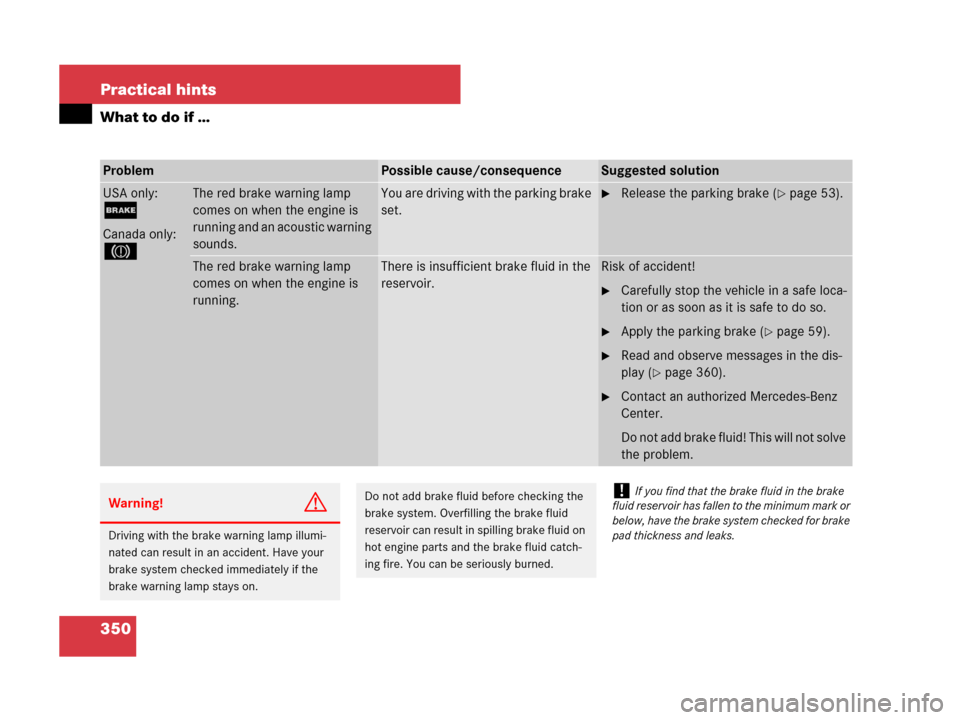
350 Practical hints
What to do if …
ProblemPossible cause/consequenceSuggested solution
USA only:
;
Canada only:
3
The red brake warning lamp
comes on when the engine is
running and an acoustic warning
sounds.You are driving with the parking brake
set.�Release the parking brake (�page 53).
The red brake warning lamp
comes on when the engine is
running.There is insufficient brake fluid in the
reservoir.Risk of accident!
�Carefully stop the vehicle in a safe loca-
tion or as soon as it is safe to do so.
�Apply the parking brake (�page 59).
�Read and observe messages in the dis-
play (
�page 360).
�Contact an authorized Mercedes-Benz
Center.
Do not add brake fluid! This will not solve
the problem.
Warning!G
Driving with the brake warning lamp illumi-
nated can result in an accident. Have your
brake system checked immediately if the
brake warning lamp stays on.
Do not add brake fluid before checking the
brake system. Overfilling the brake fluid
reservoir can result in spilling brake fluid on
hot engine parts and the brake fluid catch-
ing fire. You can be seriously burned.!If you find that the brake fluid in the brake
fluid reservoir has fallen to the minimum mark or
below, have the brake system checked for brake
pad thickness and leaks.
Page 352 of 474
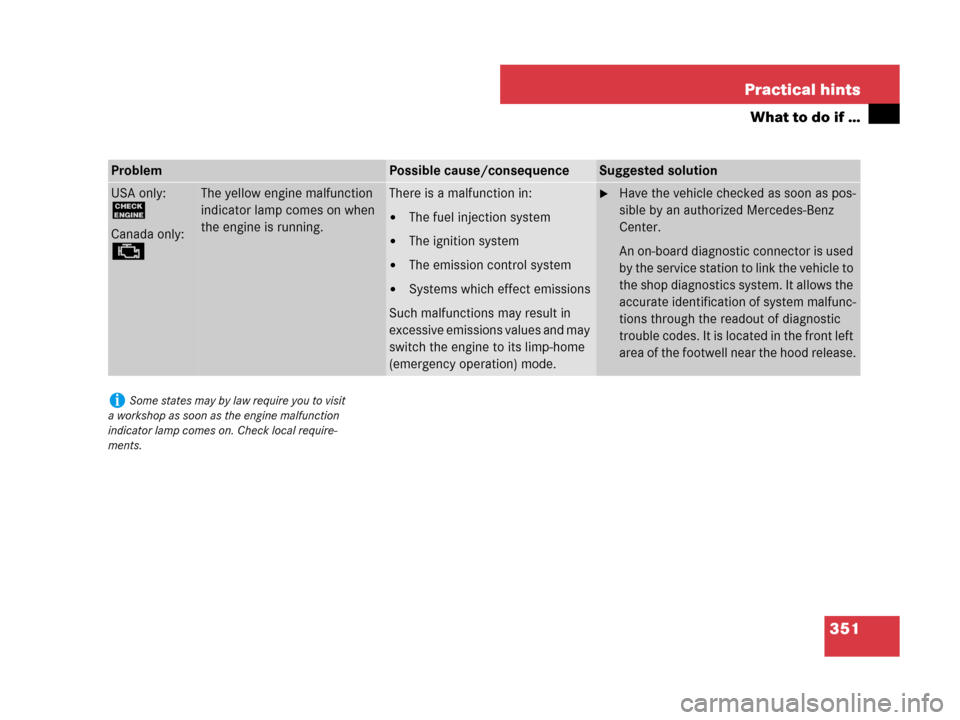
351 Practical hints
What to do if …
ProblemPossible cause/consequenceSuggested solution
USA only:
?
Canada only:
±
The yellow engine malfunction
indicator lamp comes on when
the engine is running.There is a malfunction in:
�The fuel injection system
�The ignition system
�The emission control system
�Systems which effect emissions
Such malfunctions may result in
excessive emissions values and may
switch the engine to its limp-home
(emergency operation) mode.
�Have the vehicle checked as soon as pos-
sible by an authorized Mercedes-Benz
Center.
An on-board diagnostic connector is used
by the service station to link the vehicle to
the shop diagnostics system. It allows the
accurate identification of system malfunc-
tions through the readout of diagnostic
trouble codes. It is located in the front left
area of the footwell near the hood release.
iSome states may by law require you to visit
a workshop as soon as the engine malfunction
indicator lamp comes on. Check local require-
ments.